
This article is the sixth installment in a series documenting the historic undertaking of the three-year voyage of Hōkūle‘a, a full-scale replica of a wa‘a kaulua (Polynesian double hulled voyaging canoe) around the world.
As the first of the fleet of canoes escorting Hōkūle‘a enters the channel to Magic Island, many remember when Hōkūle‘a first left Honolulu on its first international leg of the World Wide Voyage in May 2014. A crowd in the tens of thousands, growing to an estimated 50,000 by the end of the day, have converged on Magic Island to witness this auspicious event.

Almost everyone is bedecked in a t-shirt, hat, or traditional regalia signifying their connection to, or pride in, Hōkūle‘a and the World Wide Voyage. Some remember the year before departure as the “official” start when Hōkūle‘a made her way around the Hawaiian island chain, stopping at multiple ports on each island to bid Hawai‘i a fond farewell and collect the love and aloha of Hawai‘i’s people, much like an islander will visit their immediate and extended family before embarking on a long trip. Some were there three years ago when Hōkūle‘a first left Hawaiian waters on the World Wide Voyage. Some were present when Hōkūle‘a returned to Magic Island in 1976, on the return leg of its maiden voyage to Tahiti. Everyone has a special connection to the canoe and this voyage.
As for me, the World Wide Voyage started 10 years ago on a dock in Marinoa City, Fukuoka, Japan. We were on the second half of the Kū Holo Mau, Kū Holo Lā Komohana voyage that first took us to Satawal in Micronesia to deliver the gift of a canoe to our teacher, Grand Master Navigator Pius “Papa Mau” Piailug. The first half, Kū Holo Mau (Sailing to honor Mau), took the canoes Hōkūle‘a and Alingano Maisu from Hawai‘i to Satawal, where the Alingano Maisu would be presented to Papa Mau and the people of Satawal in a show of gratitude and humility to have been entrusted with such great knowledge from such a humble man. As Hōkūle‘a left Satawal, Kū Holo Lā Komohana (Sailing into the direction of Lā-Komohana, off of West) began, tracing the path of our King Kalākaua as he sailed to meet with Emperor Meiji of Japan in 1881.
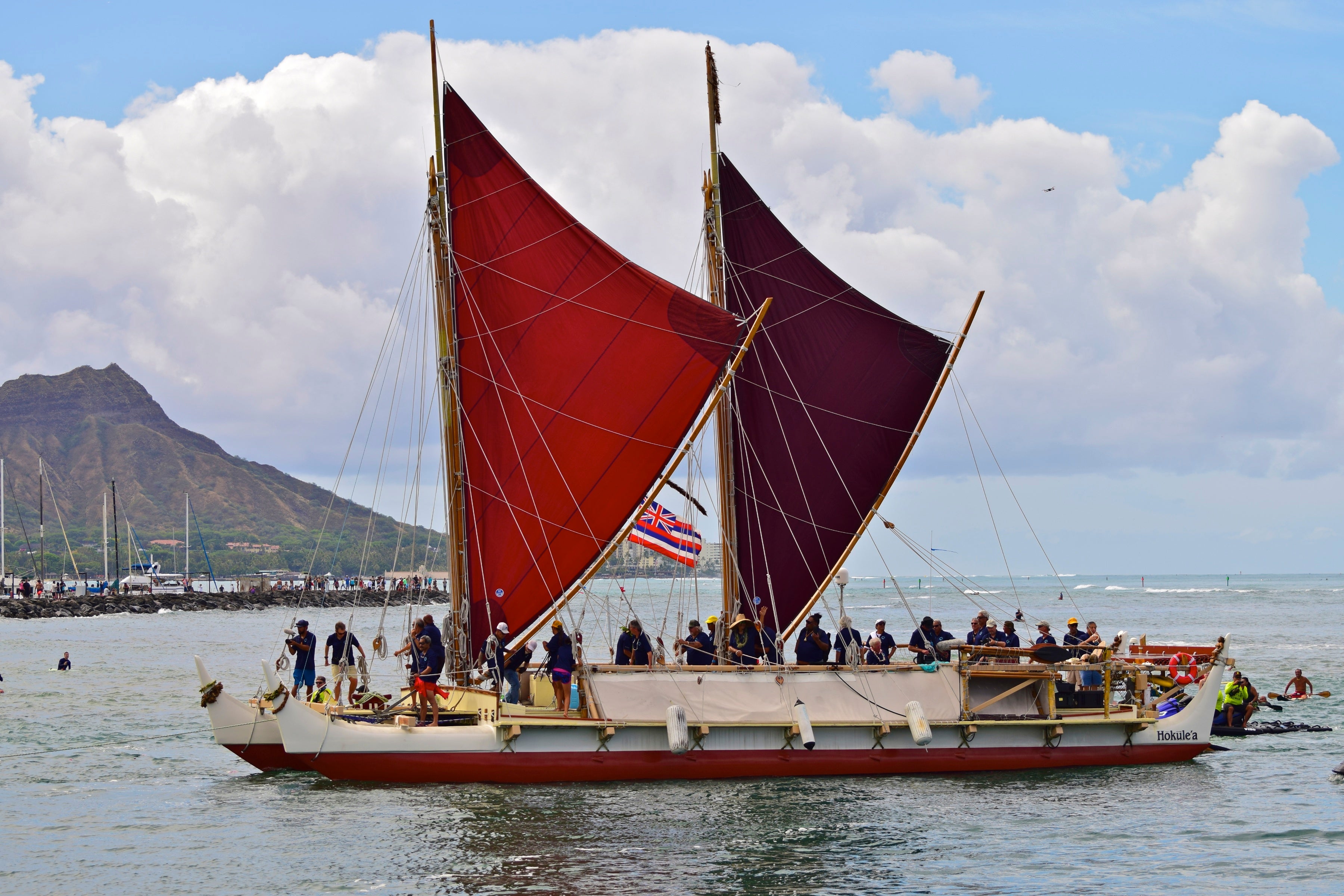
King Kalākaua was the first monarch ever to circumnavigate the globe, a feat that he did not once, but twice, in 1881 and 1887: a foreshadowing of this voyage, perhaps? As we worked on the dock in Fukuoka, we received sad word that Hōkūle‘a’s first captain to sail her to Tahiti, Elia “Kāwika” Kapahulehua, had passed away back in Hawai‘i. After our crew offered up remembrances in the form of prayers, song, dance, chant, and stories, we reflected on our current voyage, and the first voyage of Hōkūle‘as some 31 years prior, and wondered what we had in store for the future. It was dockside that our voyaging leadership began to plan out the next steps. We had talked about sailing around the world before. But now, there seemed to be an even greater sense of urgency.
When we got back to Hawai‘i a few months later, the leadership of the ‘Ohana Wa‘a (Family of the canoes) met at Nā Kālai Wa‘a‘s Hō‘ea site in Kohala, Hawai’i island, and Nainoa Thompson, head of the Polynesian Voyaging Society, laid out the first sail plan for the World Wide Voyage and elicited the support of the ‘Ohana Wa‘a to sail around the world with the idea of sharing Indigenous knowledge and wisdom from here in Hawai‘i in order to bring awareness of our planet, our “Island Earth,” of which we all have a stake in. And thus, a voyage was born.
But this was no ordinary voyage. It would take the next six years to properly research the route, rebuild the canoe, conduct sea trials, and train the huge crew that it would take to pull this voyage off. Thousands of volunteers came forth to put their mana (spirit and power) towards preparing Hōkūle‘a for this next large chapter of her life. This meant dismantling her down to bare hulls, and building her back up to be able to handle sea conditions in unfamiliar oceans, conditions unlike those through which we have been sailing over the last 38 years. Of these volunteers, a few hundred rose to the challenge to complete the rigorous training required to become a crew member on the voyage. This involved physical conditioning with a test that included physical exertion exercises, a timed mile run, and a timed mile swim. It also involved mastering basic seamanship skills, first aid skills, ocean survival skills, specialized Polynesian voyaging skills, a basic understanding of traditional Hawaiian non-instrument navigation, and mastery of at least one other specialized skill. On the voyage, each crew member is responsible for at least one specialized assignment, along with pitching in on other roles from steering, to cooking, to fishing, to repairs and maintenance. I had the privilege of serving as protocol officer, education specialist, and navigator, although like every single one of my crewmates, we pitched in and did every job on the canoe that needed to be done.
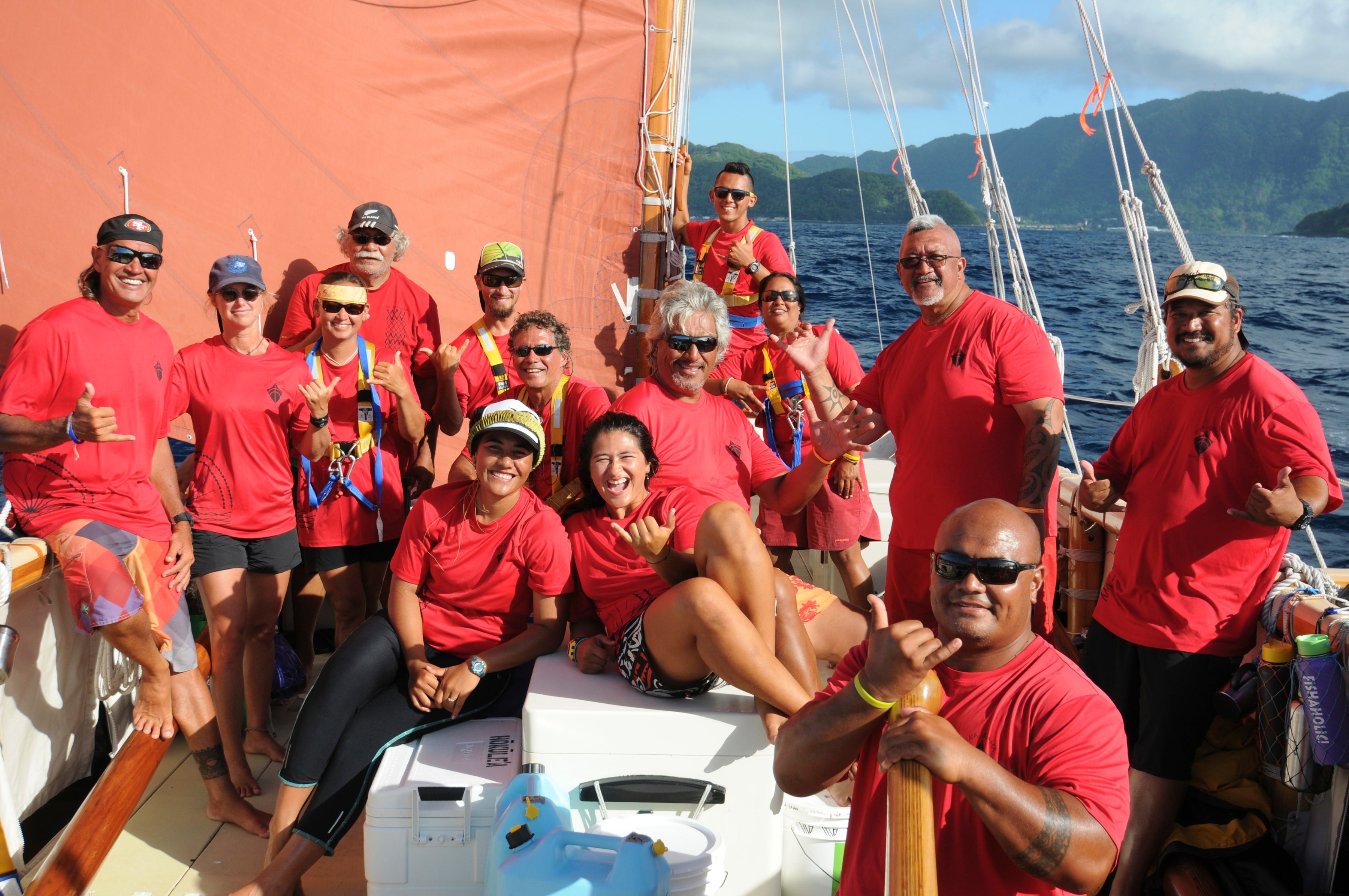
Photo by Kamakanioka‘a–ina Paikai.
Once the dry dock was finished and the newly reconfigured Hōkūle‘a was launched, it was time for sea trials and crew shakedown. A brief set of sea trials were conducted, and we made ready for the Mālama Hawai‘i voyage (caring for Hawai‘i). This was a voyage throughout the island chain, visiting numerous communities on each island and crossing every channel in Hawai‘i, which would serve as the final real life sea trial and crew readiness test before leaving Hawaiian waters. This inter-island voyage was not intended as a sea trial, but more so to visit each island and gather the aloha and mana of our people in order to take that with us as we traveled around the world. At the conclusion of the Mālama Hawai‘i statewide voyage, Hōkūle‘a returned to O‘ahu for a final provisioning before setting sail on its first international leg. Next stop, Tahiti.
As we circumnavigated the world over the last three years from May 2014 through June 2017, we traveled 42,000 nautical miles, stopped at over 150 ports in more than 23 countries and territories, and visited eight of UNESCO’s Marine World Heritage sites. When we left Hawai‘i in May, we headed to Tahiti where we stopped at all of the major French Polynesian islands, with special visits to Taputapuātea on the island of Raiatea, and a first time landing on the island of Maupiti, before continuing on to the Cook Islands with stops at Rarotonga and Aitutaki. After leaving the Cook Islands we made our way to Samoa, first paying homage to the chiefly Manu‘a islands before stopping in American Samoa, then continuing on to Western Samoa. From Western Samoa we continued south to Tonga, then on to Aotearoa, the land of the long white cloud. After a dry dock in Aotearoa, we crossed the Tasman Sea, our first time outside of the Pacific proper, arriving in Southeastern Australia and making our way north along the Northeast coast until leaving the continent for Bali, Indonesia. From Bali, we made our way west-southwest to Mauritius in the Indian Ocean, then rounded the southern tip of Madagascar, where we intended to make port, but were waved off in anticipation of an impending storm.
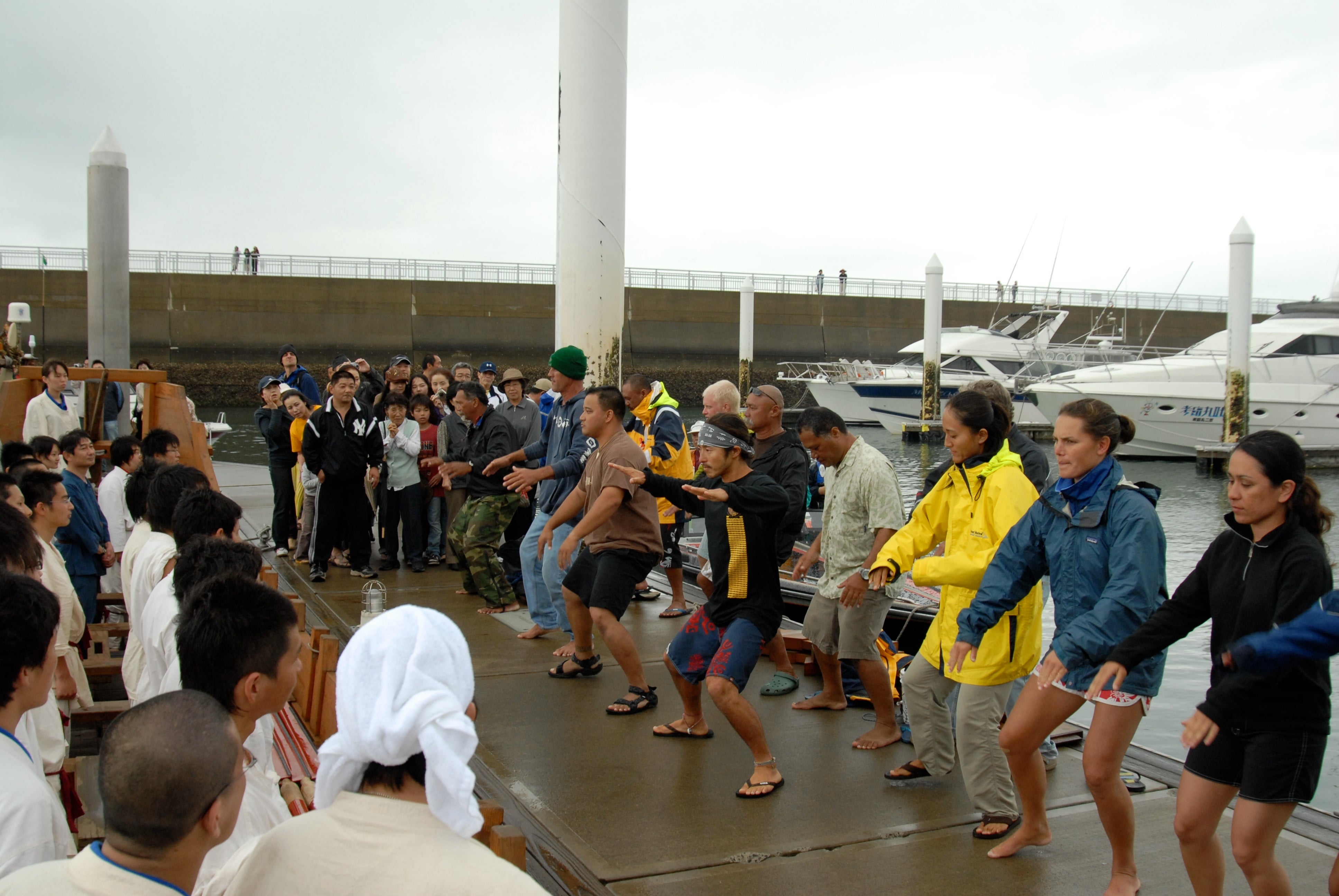
Our next intended stop was Richards Baai, the northernmost port in South Africa’s East Cape. That plan was thwarted by the storm that had closed the port on Madagascar, and instead we found our canoe heading north to seek refuge, anchored in the bay in Maputo, Mozambique. Once the storm subsided, we finally made our way to Richards Baai and worked our way south, port to port, until we reached Cape Town. In Cape Town another dry dock was done to prepare the canoe for its first Atlantic crossing en route to Brazil with a stop in Saint Helena. From Brazil, we sailed northwest to the Virgin Islands, then on to an epic visit to Cuba before making our way to the eastern United States, landing in Florida. From Florida, Hōkūle‘a made her way north up the eastern seaboard, mostly through the inland waterways, making many stops along the way in areas like Washington, D.C., New York, Boston, and as far north as Montreal and Nova Scotia before coming back down to Florida for a final dry dock before heading home.
From the United States, we made our way through the Caribbean, through the Panama Canal, and onto the Galapagos Islands. From the Galapagos Islands we made our way back into Polynesia by way of Rapa Nui. From Rapa Nui, we made our way through the Polynesian Islands back to Tahiti where Hikianalia, Okeanos Marshall, and Faafaite joined Hōkūle‘a on her final leg of the World Wide Voyage, and sailed with us home to Hawai‘i. As the fleet of canoes neared Hawaiian waters, other deep sea voyaging canoes mobilized to meet the fleet at various points in Hawai‘i and sail with her to this homecoming at Magic Island. Makali‘i from Kawaihae-Hawai‘i Island, Mo‘okiha from Maui, and Nāmāhoe from Kaua‘i all set sail from their respective islands and joined our mother canoe, Hōkūle‘a, for her homecoming on O‘ahu.
I am brought back from my reflections as the pū (conch shell) blows once again, signaling the arrival of another canoe into the channel. The first canoe to arrive was the 70-foot Nāmāhoe of Kaua‘i, the largest Hawaiian made canoe in our fleet, and the most recently launched. Following Nāmāhoe was Mo‘okiha-o-Pi‘ilani of Maui, then Makali‘i of Kawaihae-Hawai‘i Island. The next canoe in was Hawai‘iloa, the canoe made from the spruce logs gifted to us by the Tlingit Haida tribes of Alaska so that we could carve a traditional canoe from single logs, as was custom in times gone past. Next in was Okeanos Marshall Islands, a short, single mast voyaging canoe perfect for interisland commuting and transport. Okeanos will be making its way to the Marshall Islands after the homecoming where she will gain a new home port. After Okeanos, our next visiting canoe arrived, Faafaite of Tahiti. Faafaite accompanied Hōkūle‘a and Hikianalia on Leg 2 of the World Wide Voyage from Tautira throughout French Polynesia and onto Rarotonga before returning to her homeport of Tahiti.
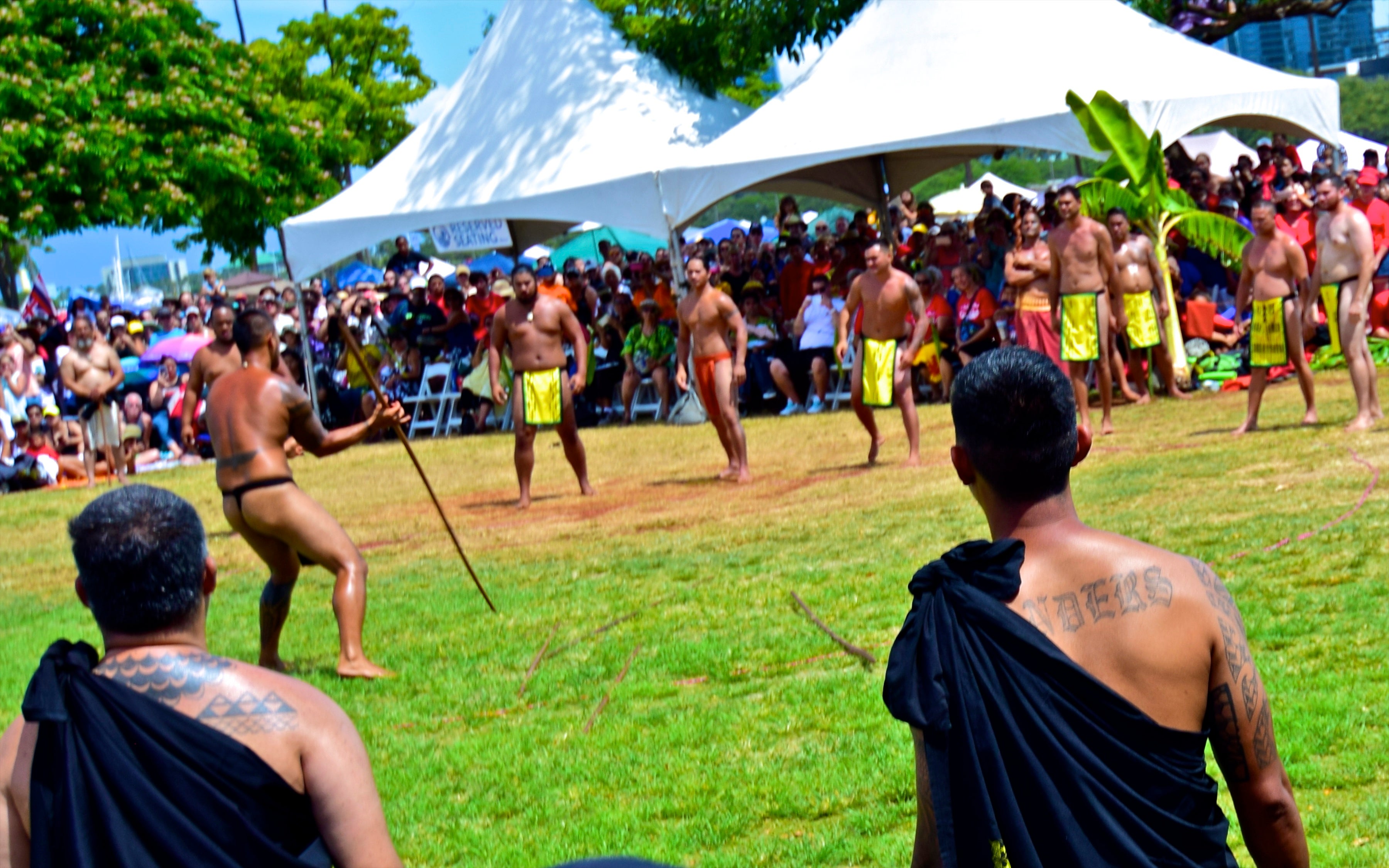
Now that the homecoming escorts have entered and tied up as a flotilla, the stars of the show line up for an entrance. First up is Hikianalia, Hōkūle‘a‘s sister canoe and Pacific Ocean escort, who escorted Hōkūle‘a from Hawai‘i to Aotearoa at the beginning of the voyage, and who sailed to Tahiti at the end of the voyage to escort her home. Once all of the canoes were safely docked, the celebratory events were ready to commence. However, there was one last task to be undertaken before any celebrations were to be had. A warrior representing the canoes had to participate in a Kāli‘i ceremony, a ceremony that had not been done in over 200 years. In this ceremony the warrior first offers up oratory of the canoes travels and the braveness and compassion of its voyagers in the face of extreme conditions and the human element they faced as they sailed from place to place. Once the oratory was concluded, the warrior had to prove his worthiness and the worthiness of those he represented by deflecting multiple spears hurled at him from different angles, and catching the last spear thrown. This feat was accomplished by crew member Sam Kamu Kapo‘i in superb fashion. As the ‘ōlelo no‘eau (Hawaiian proverb) states, He Wai ‘Au‘au, the task was “but a leisurely swim.”
The crews of this final leg then made their way to the tent for an ‘awa (kava) ceremony, speeches, song, dance, and presentations. Although a small fraction of the crew were partaking in the festivities under the tent, the rest of the crew and hundreds of volunteers were busy caring for the tens of thousands of people who had come to be a part of this once in a lifetime occasion. An important responsibility was accepting
the offerings for Hōkūle‘a and placing them aboard the wa‘a. The youth of Nā Pe‘a of Kona, Hawai‘i island offered the famous sun dried ‘ōpelu (a local mackerel) from their region along with kalo (taro root) to nourish the sailors and the canoe. Hinaleimoana offered up a soul-stirring chant. The ‘ohana from Ko‘olauloa offered up kapa cloth, leis for each canoe, and song and dance. The ‘ohana of Maui offered up a lei lā‘ī (Ti-leaf lei) a mile long. Every offering was replied to with the proper protocol, often matching the offerings. Much aloha was given and received on this historic day, a day not soon to be forgotten.
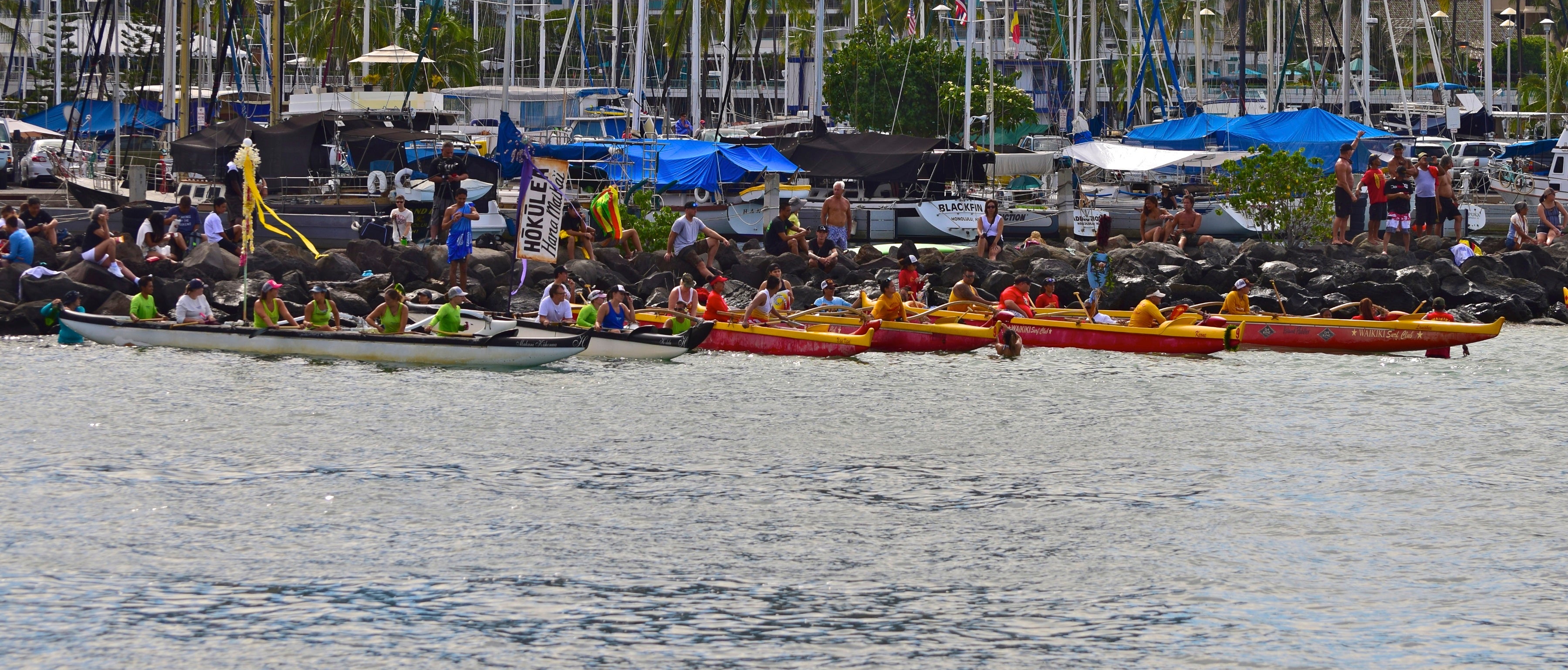
We have an educational and informational symposium of the World Wide Voyage over the next three days at the neighboring convention center, but the voyage is not yet over. As we began the voyage with a sail around our islands to gather the aloha, mana, and support from our people to share with the world, so must we return the aloha, mana, and support we gained from the people of the world, and share it with our families that sent us off and took care of our responsibilities while we were gone. And once that voyage is over, we have many canoes here in Hawai‘i that need to sail to distant shores, who waited patiently and supported Hōkūle‘a, putting aside their sail plans to be a part of this epic voyage. As a mother sets the example and allows her children to follow suit and learn on their own, these canoes are chomping at the bit to follow in the footsteps of Māmā Hōkūle‘a, to sail to faraway lands over the deep blue sea and make her proud.
—Kaimana Barcarse is the West Hawai‘i regional director for Kamehameha Schools, and the program director and lead DJ of Alana I Kai Hikina on KWXX-FM. Barcarse also serves on the board of directors at Cultural Survival and chairs the board of The Cultural Conservancy.
Visit www.cs.org for the original Hawaiian language version of this story. Visit goo.gl/Hjxa2p for previous articles documenting the World Wide Voyage.
Photos by Kaimana Barcase.
